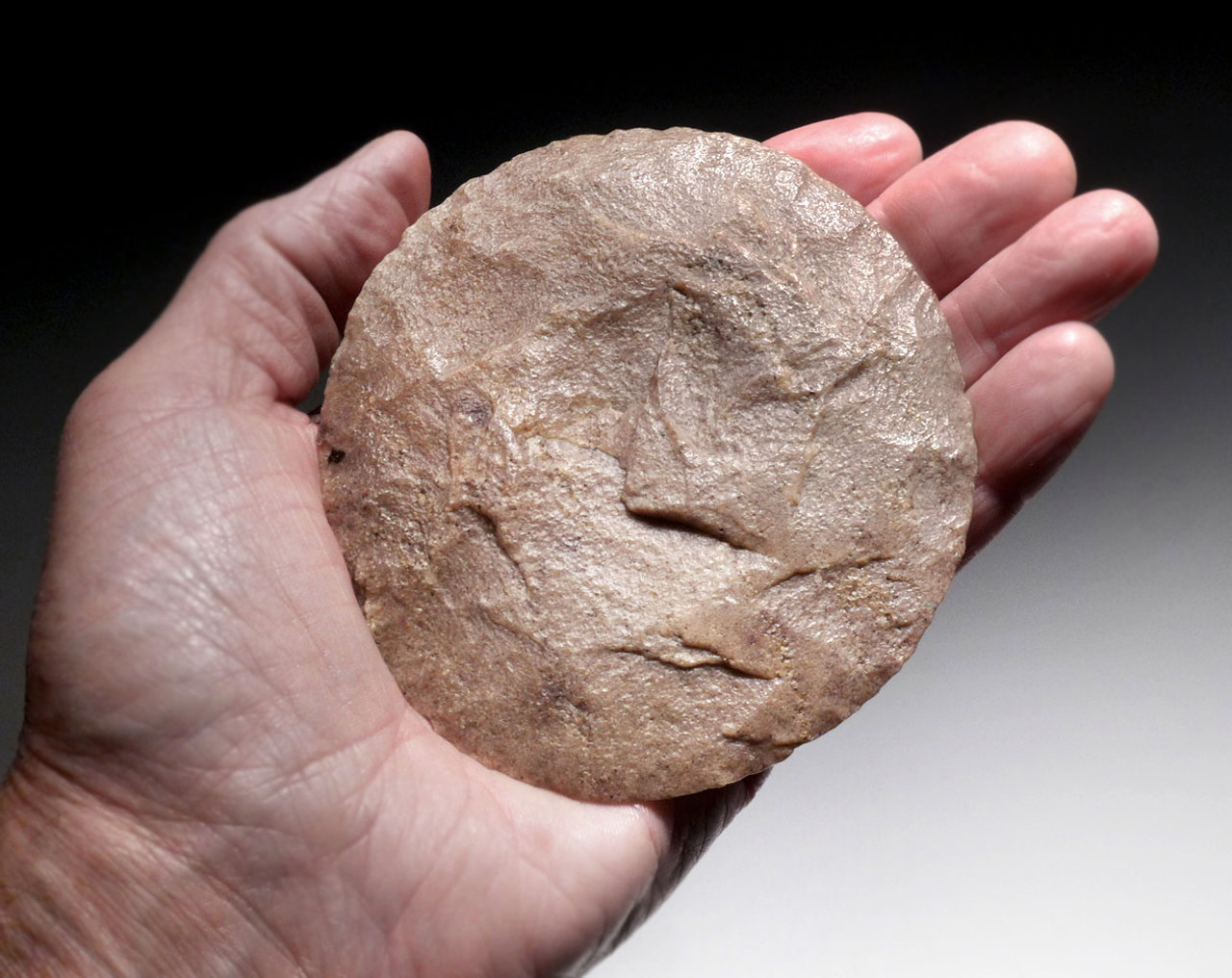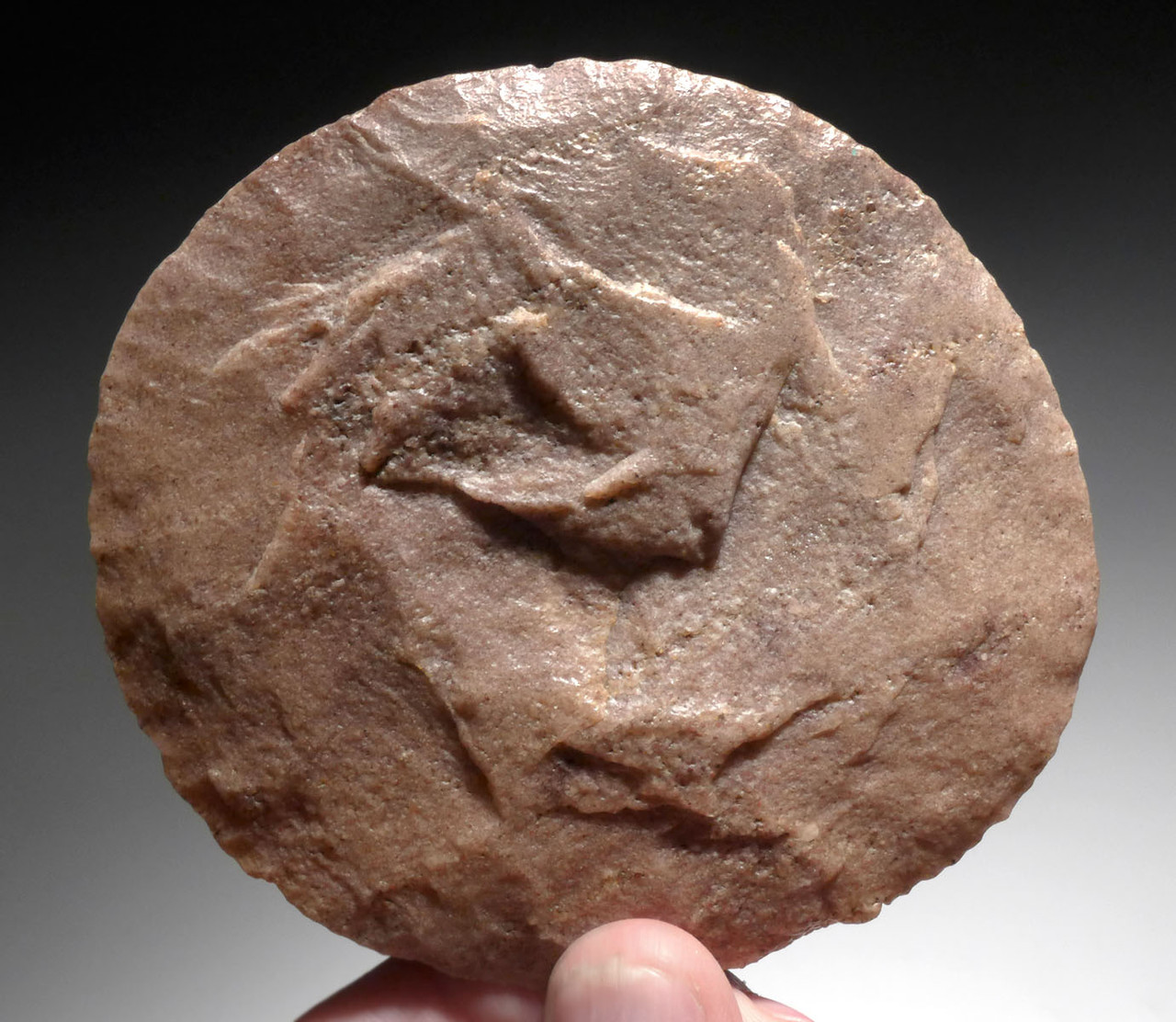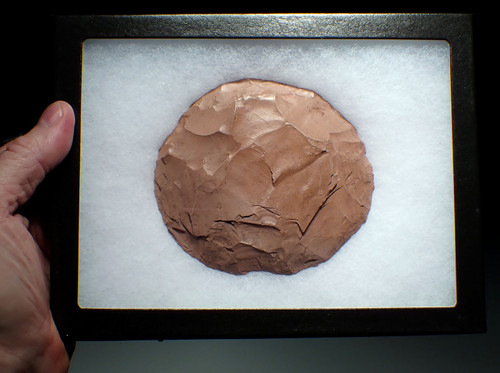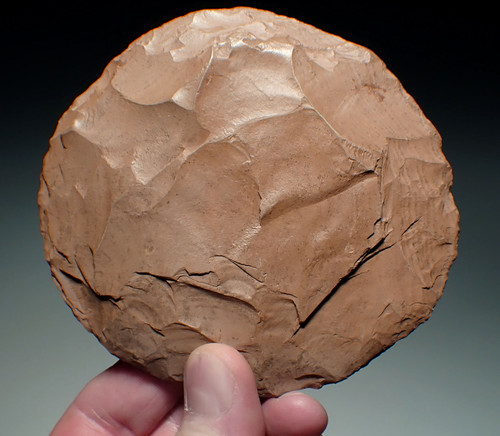Product Description
SEE MORE AFRICAN NEOLITHIC TOOLS
On a dinosaur fossil-hunting expedition in 2000 by a team of scientific explorers led by Paul Sereno, a paleodune and ancient lakebed site was discovered that yielded over 200 ancient burials of Kiffian and Tenerian people. The scientific findings showed that this area was once a humid lake region that was home to a hunter-fisher-gatherer people. The area became known as the "Green Sahara" for its once fertile and habitable landscape. Noted paleontologist, Dr. Paul Sereno, famous for other Saharan dinosaur discoveries, shot into the archaeological spotlight with his discovery of the ancient lakebed cemetery at Gobero in Niger in the year 2000. Interred in the many burials were numerous stone tools, ceramics, shells, beads and bone harpoons typical for the lifestyle of these ancient people of the Green Sahara. This exceptional AUTHENTIC artifact is similar to the specimens found at Gobero. It comes from the same period and Tenerian Neolithic Culture of that famous discovery.
Of all the unique objects that are known from this rare African Neolithic culture, expertly made, thin bifacial "sun disk" objects are considered one of the most unusual and iconic. While most of these were flaked in green jasper, this incredibly rare specimen was flaked with the same thinness, in pinkish red sugar quartz. Sugar quartz is extremely tough and difficult to work with. It is nearly impossible to flake to any thin proportion. How this discoidal scraper was made to the same thinness as jasper is a mystery and, quite a demonstration of the true Neolithic master artisan that was able to achieve such a feat. This is the only time we have seen such a disk scraper made of a stone other than jasper, to such a thin profile. The entire circumference is perfectly made with very light secondary retouch flaking. The entire surface has a wonderful luster caused by its 'desert varnish' patina from extreme long-term desert exposure to the blowing sands and minerals.
The term 'sun disk' was coined by some collectors and no one knows if these were meant to be actually effigies of the sun, as their purpose is completely enigmatic. The Tenerians flaked extremely fine bifacial circles (in mostly green jasper), ranging in size from 2 to 3 inches, to up to nearly 6 inches in diameter, most with exceptionally thin cross-sectional thickness. The flaking and workmanship, as well as the incredibly symmetrical circular shapes rule them out as being ordinary utilitarian tools. Were they used for trade currency, displays of prestige and wealth, or reserved for a high-level members of the tribes? It is not known but the knapped form to the level that they Tenerians achieved, and the green jasper lithic used, is unlike anything found in any other Neolithic culture of the world. Regardless of their purpose, these objects represent prehistoric and Neolithic artistic creation and expression.
While we have offered various Tenerian green jasper scrapers in the past including some small disk scrapers, nothing we have ever offered before is of this caliber in sugar quartz. This comes from our private collection of the best specimens we reserved, built over 24 years.
It's an artifact like this that makes the Tenerian Neolithic so amazing. This is a thin profile BIFACIAL DISK SCRAPER. Its size and workmanship indicate it was an object of prestige, too well-made to damage with everyday use. Both sides shows exceptional and naturally lustrous 'desert varnish'. All the flaking is as originally made with the finest workmanship of a highly skilled artisan. There is NO MODERN FLAKING anywhere on this piece as evidenced by the original sediment from the site still attached in the flake scars - a feature ONLY seen in AUTHENTIC examples.
If you want the pinnacle of craftsmanship from the Tenerian Neolithic stone tool culture, then THIS is a MUST HAVE, important and rare object to have in your collection.
Tenerian Neolithic disk scraper objects like this, are legendary in prehistory. No other ancient or prehistoric stone tool culture in the world has ever matched the workmanship and beauty of Tenerian bifacial flaked stone disks. This is an exceptional example of these "mascot" objects of this Neolithic society. The site where these were once found is completely clean and long since fully collected by modern nomads. .
COMPLETE AND PERFECT AS ORIGINALLY MADE. NO RESTORATION and NO REPAIR.
We are very fortunate to have acquired an old French collection of these artifacts, years ago. Nevertheless, we have a very limited amount and once sold, we most certainly will never be able to replace them. Objects from the Tenerian African Neolithic culture are so rare that not even most major museums have a single object in their collection.
HISTORY
The Earth has been warming and cooling for millions of year, well long before humans were on the planet. One of the most dramatic examples of climatic change in the last 10,000 years is the desiccation of what is now the Sahara desert. Prior to as recent as 3000 B.C., the South Central Sahara region in Africa was a humid lake savanna. It was home to a thriving culture of ancient humans known as the Tenerians and before them, the Kiffians. The occupation of this area by these two peoples occurred continuously from around 7700 B.C. to the drying of the Sahara in 2500 B.C..
In the final Pleistocene and early Holocene Periods around 10,000 years ago, the South Central Sahara Desert was once a highly favorable environment for hunters, gatherers and pastoralists. Freshwater lakes existed between the dunes in what is now the Tenere region, Lake Chad was eight times its current size, the highlands supported Mediterranean forest trees, and a diverse variety of both large and small fauna flourished there. The slow drying out process of the Sahara, began 7,000 years ago and ended 4500 years ago resulting in the barren conditions that exist to this day. As we progress through time from the end of the Pleistocene towards the end of the Neolithic Period there, we see humans relying more on meat from raised animals as opposed to hunted animals that once roamed wild in the formerly Green Sahara.
 US DOLLAR
US DOLLAR
 EURO
EURO
 AUSTRALIAN DOLLAR
AUSTRALIAN DOLLAR
 CANADIAN DOLLAR
CANADIAN DOLLAR
 POUND STERLING
POUND STERLING






















